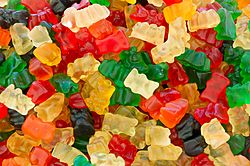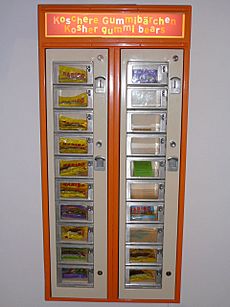Gummy bear facts for kids

Gummy bears produced by Haribo, the first company to manufacture gummy bears
|
|
| Type | Gummy candy |
|---|---|
| Place of origin | Germany |
| Created by | Hans Riegel Sr. |
| Main ingredients | Gelatin, sugar, glucose syrup, starch, flavoring, food coloring, citric acid |
Gummy bears are small, chewy candies shaped like bears! They are a type of fruit gum candy, a bit like jelly babies. Most gummy bears are about 2 centimeters (less than an inch) long. They are super popular gelatin-based candies that come in many fun shapes and colors from different companies, like Haribo.
Contents
The Sweet History of Gummy Bears
Gummy bears first came from Germany. People there call them Gummibär, which means "gum bear," or Gummibärchen, meaning "little gum bear." The "gum" part of their name comes from gum arabic, which was the first ingredient used to make them.
A candy maker named Hans Riegel Sr. started the Haribo company in Bonn, Germany, in 1920. In 1922, he got an idea from the trained bears he saw at street festivals. He invented a small, fruit-flavored candy called the "Dancing Bear" (Tanzbär). It was a treat that kids and adults could afford, even during a tough economic time in Germany. The Dancing Bear was bigger than the gummy bears we know today. Later, in 1967, the "Dancing Bear" became the famous "Gold-Bear" (Goldbär) candy from Haribo, which is loved all over the world!
Fun Gummy Bear Shapes and Flavors
Because gummy bears were so popular, candy makers started creating many other gummy candies. You can find them shaped like all sorts of animals and objects, such as worms, frogs, sharks, penguins, cherries, and even hamburgers! Some companies even make giant gummy bears that weigh several kilograms.
In the United States, Haribo gummy bears come in five main flavors:
- Red: Raspberry
- Orange: Orange
- Green: Strawberry
- Clear/Colorless: Pineapple
- Yellow: Lemon
Other companies, like Trolli, have similar flavors but sometimes different ones for the same colors. For example, Trolli's red bear is strawberry, and their green one is lime. Some healthier brands use natural flavors and offer unique tastes like grape or peach.
How Gummy Bears Are Made
Traditional gummy bears are made from a mix of sugar, glucose syrup, starch, flavoring, food coloring, citric acid, and gelatin. But recipes can change, especially for organic candies or those made for vegetarians or people who follow special religious dietary rules.
Gummy bears are made using a special machine called a "starch mogul." Here's how it works:
- First, the shape of the gummy bear is pressed into a tray filled with powdered starch.
- Then, the hot, liquid candy mix is poured into these bear-shaped holes.
- The candy cools and sets overnight.
- Once firm, the candies are taken out of the molds and packaged.
Since the molds are open at the top, only the front of the bear is shaped, and the back stays flat. The original design for each candy is first carved by an artist, then copied by a machine to create the molds.
Some gummy bears are made with gelatin from cows, pigs, or fish. This means they are not suitable for vegetarians or vegans. Also, some religious dietary laws, like kashrut or halal, have rules about how animals are prepared. Haribo has a factory in Turkey that makes halal gummy bears using gelatin from cows. You can also find gummy bears made with pectin or starch instead of gelatin, which are good choices for vegetarians.
Sour gummy bears are often larger and flatter. They have a softer texture and get their sour taste from ingredients like fumaric acid. Some sour bears use starch instead of gelatin, which gives them a different, less chewy texture.
Gummy Bears and Your Health
| Nutritional value per 100 g (3.5 oz) | |
|---|---|
| Energy | 1,459 kJ (349 kcal) |
|
77 g
|
|
| Sugars | 46 g |
|
0 g
|
|
|
Protein
|
6.9 g
|
| †Percentages estimated using US recommendations for adults. | |
Gummy bears usually contain mostly empty calories, which means they give you energy but not many important nutrients. However, some companies now make gummy bears with added vitamin C or other vitamins. These are sometimes marketed to parents to help picky eaters get their vitamins.
One thing to remember is that gummy bears, like other chewy candies, can stick to your teeth. This can sometimes lead to tooth decay if you don't brush well. Scientists are even testing gummy bears that contain xylitol, a type of sugar that can help fight cavities! Some companies, like Trolli, have also created special gummy candies that they claim can help your immune system and teeth.
See also
 In Spanish: Osito de goma para niños
In Spanish: Osito de goma para niños
- Disney's Adventures of the Gummi Bears
- Turkish delight
- Albanese Candy, an American brand



